by Theodore Harris and Frank M. Wilhelm, Department of Fish and Wildlife Resources, College of Natural Resources, University of Idaho
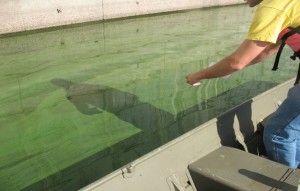
Fig. 1: On 2 October 2011, thousands of alkali flies were seen at Willow Creek Reservoir, OR. The flies were concentrated at the shoreline of the reservoir and near/on the reservoir dam. Photo by Frank Wilhelm. (click to enlarge)

Fig. 2: Alkali flies found on an experimental enclosure on 2 October 2011 at Willow Creek Reservoir. Photo by Frank Wilhelm. (click to enlarge)
Have you ever experienced a lakeshore totally blackened by housefly-like flies, making you wonder what died, because only something like roadkill typically attracts such hordes? That was our reaction when we visited Willow Creek Reservoir (WCR) in Heppner, OR in early October for routine water sampling. Something was strange, though — the flies were not the pesky housefly type and seemed uninterested in us. They rafted on the water, and even seemed to crawl into it at the sides of the lake and along our experimental enclosures only to re-emerge, apparently none the worse for their underwater journey. This piqued our interest and made us take a closer look. It turns out that we witnessed an eruptive hatch of “brine” or “alkali” flies of the family Ephydridae (Fig. 1 & 2).
We spent some time that afternoon watching the flies and noting their actions, taking pictures, and capturing specimens for identification. The next day we took the specimens to the resident aquatic entomologist here at the University of Idaho who was more than willing to trade his office for the lab to identify them. After carefully mounting them for examination, it was off to the high power microscope to find diagnostic features mentioned in various keys. A positive identification of Ephydra hians was made. This is one of four species of “brine” or “alkali” flies distributed throughout the western part of North America in shallow saline and/or alkaline lakes (Fig. 3). Their common name derives from the habitats in which they are commonly found — highly saline and/or very alkaline environments like those of Mono Lake, CA and Abert Lake, OR, where only the fly and brine shrimp can survive (Wirth 1971). What makes our observation unique is that WCR is neither saline nor alkaline, but freshwater with moderate alkalinity. Even more intriguing is the fact that there are no saline or alkaline waters near WCR (Fig. 4), leading us to conclude that they had hatched locally.

Fig 3: North American distribution of three species of Ephydra; cinerea (filled circles), currani (open squares), and hians (filled squares). Figure modified from Wirth 1971. (click to enlarge)
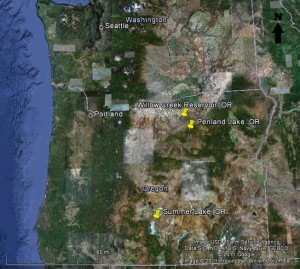
Fig. 4: The location of Willow Creek Reservoir, OR (WCR) in relation to Penland Lake, OR, the closest water body to WCR, and Summer Lake, OR, the closest salt lake to WCR. Image by Google Earth. (click to enlarge)
A review of the literature turned up some interesting facts. Hatches of the fly can be so abundant in some areas that adults and pupae wash up on shore in great windrows (Fig. 5), which historically were harvested and prepared as a food source known as “Koo-chah-bee” by the Paiute Indians of California and Nevada (Aldrich 1912; Essig 1934; Wirth 1971). Because of their extreme abundance, the flies have been of interest to naturalists, including Mark Twain, who described them in Roughing It:
You can hold them under water as long as you please–they do not mind it—they are only proud of it. When you let them go, they pop up to the surface as dry as a patent office report, and walk off as unconcernedly as if they had been educated especially with a view to affording instructive entertainment to man in that particular way. – Roughing It (1872)
The highly alkaline environment in which the flies live presents unique osmotic (balance of internal body conditions) challenges. They avoid desiccation by excreting salt, while a specialized organ known as the lime gland is used to remove excess carbonate and bicarbonate (picked up from the alkaline environment) from their blood (Herbst and Bradley 1989). Through chemical reactions, this excess material is converted to limestone and stored (Herbst and Bradley 1989; Herbst 1999). When pupae metamorphose to adults the limestone is excreted (MBEIR 1993).
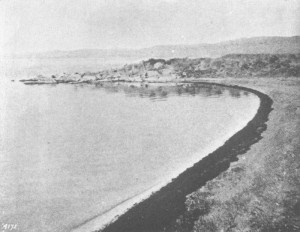
Fig. 5: A view from the shoreline of Mono Lake, CA during the early 1900’s. The black shoreline is actually windrows of alkali pupae and adults. Figure modified from Essig 1934. (click to enlarge)
Because brine fly eggs are non-sticking, mated females lay eggs underwater by tucking them into vegetation to keep them from being washed away by water currents. Adults raft in swarms on the water’s surface (Fig. 6), feeding on diatoms, filamentous green algae, and cyanobacteria (Herbst 1988; Herbst pers. comm.). This raises an interesting question – are brine flies a potential vector of cyanotoxins from the aquatic to the terrestrial environment? When we saw the flies, the cyanobacteria bloom in WCR was highly toxic, with microcystin concentrations greater than 500 µg/L (US Army Corps of Engineers unpublished data). Birds like gulls, grebes, and phalaropes (Boula 1986; Jehl 2004) are the main predators of brine flies and could be affected if the flies concentrate toxins. This could be important because the flies serve as an important food source for migrating birds in remote environments throughout the Pacific flyway (Boula 1986).
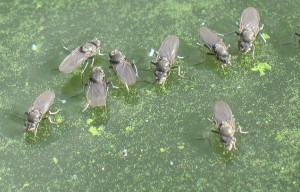
Fig. 6: Alkali flies Ephydra hians observed at Willow Creek Reservoir, OR in early October 2011 eating potentially toxic Microcystis algae. Photo by Frank Wilhelm. (click to enlarge)
The flies have a life cycle similar to other insects; all stages are aquatic except the adult stage, which is terrestrial. Deposited eggs hatch into larvae, which develop into pupae that metamorphose to mature adults. The hatching success of eggs depends on temperature and salinity, and typically requires one to three days (MBEIR 1993). Three larval instars are common (Cash and Bradley 1994), during each of which the larvae increase in size (MBEIR 1993). The duration of the larval stage can vary from four weeks to more than five months depending on temperature, salinity, and the availability of food (MBEIR 1993), which is mainly periphytic algae (Herbst 1988).
The pupal stage is initiated when larvae move to a protected area, attach themselves and become encased in a puparium. This is a light brown spongy covering that will eventually fill with gas to prevent detached free-floating pupae from sinking and burial in bottom sediments (Aldrich 1912). Throughout this stage, the organism does not move or feed, so is highly susceptible to predation; thus, the area selected for pupation affects survivorship. Survival during this stage also depends on temperature and water depth, with survival decreasing with increasing depth (MBEIR 1993). After one to three weeks, depending on temperature, the pupae detach from the substrate, float to the surface, and emerge as adults (MBEIR 1993).
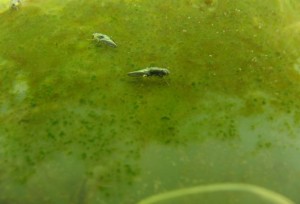
Fig. 7: Underwater view of the brine flies feeding and /or ovipositing eggs on periphyton. Photo by Frank Wilhelm. (click to enlarge)
Adult flies range in size from 4-7 mm and typically have a dark brown body, metallic blue-green thorax, and smoky gray wings (Aldrich 1912; Wirth 1971). The flies have an abundant covering of long setae (hairs) that allows them to maintain a grip on slippery substrates (Wirth 1971). In addition, these dense hairs, along with a naturally waxy skin, help create a natural air bubble around the fly when it submerges. This allows brine flies to breathe air while underwater (Fig. 7; Aldrich 1912; Wirth 1971). The average adult life span ranges from 10 to 14 days, during which adults feed and mate (MBEIR 1993).
Some interesting questions remain. Although we have been sampling WCR on a regular basis since 2008, we had never before been aware of the presence of the alkali flies. Why this year? Perhaps they are present year-round, but at such low densities that they do not draw our attention? Why were the alkali flies present in WCR? Chemically, WCR can be likened to distilled water relative to the salinity and alkalinity of water bodies in which the flies are normally found. Perhaps the occurrence was related to the record snowmelt and large flood that occurred in the WCR watershed this spring – and WCR was not their place of origin after all? These questions and others will give us something to ponder this winter. You can bet that come spring we’ll be keeping a keen eye out for flies buzzing around the lake.
References:
Aldrich, J.M. 1912. The biology of some western species of the dipterous genus Ephydra. Journal of the New York Entomological Society 20: 77-99.
Boula, K.M. 1986. Foraging ecology of migrant waterbirds, Lake Abert, Oregon. Unpublished thesis. Oregon State University.
Cash, C. and T.J. Bradley. 1994. External morphology of the larvae of Ephydra (Hydropyrus) hians (Diptera: Ephydridae). Journal of Morphology 219: 309-318.
Essig, E.O. 1934. The value of insects to the California Indians. The Scientific Monthly 38: 181-186.
Herbst, D.B. 1988. Comparative population ecology of Ephydra hians Say (Diptera: Ephydridae) at Mono Lake (California) and Abert Lake (Oregon). Hydrobiologia 158: 145-166.
Herbst, D.B. 1999. Biogeography and physiological adaptations of the brine fly genus Ephydra (Diptera: Ephydridae) in saline waters of the Great Basin. Great Basin Naturalist 59: 127-135.
Herbst, D.B. and T.J. Bradley. 1989. A malpighian tubule lime gland in an insect inhabiting alkaline salt lakes. Journal of Experimental Biology 145: 63-78.
Jehl, J. R. 2004. Carnivorous Canada geese. The Wilson Bulletin 116: 179-180.
Mono Basin Environmental Impact Report (MBEIR). 1993. Appendix 1. Natural history of the Mono Lake alkali fly. Accessed on 10 Nov 2011 from http://www.monobasinresearch.org/images/mbeir/dappendix/app-i-text.pdf.
Twain, M. 1872. Roughing It. American Publishing Company.
Wirth, W.W. 1971. The brine fly of the Genus Ephydra in North America (Diptera: Ephydridae). Annals of Entomological Society of America 64: 357-377.









